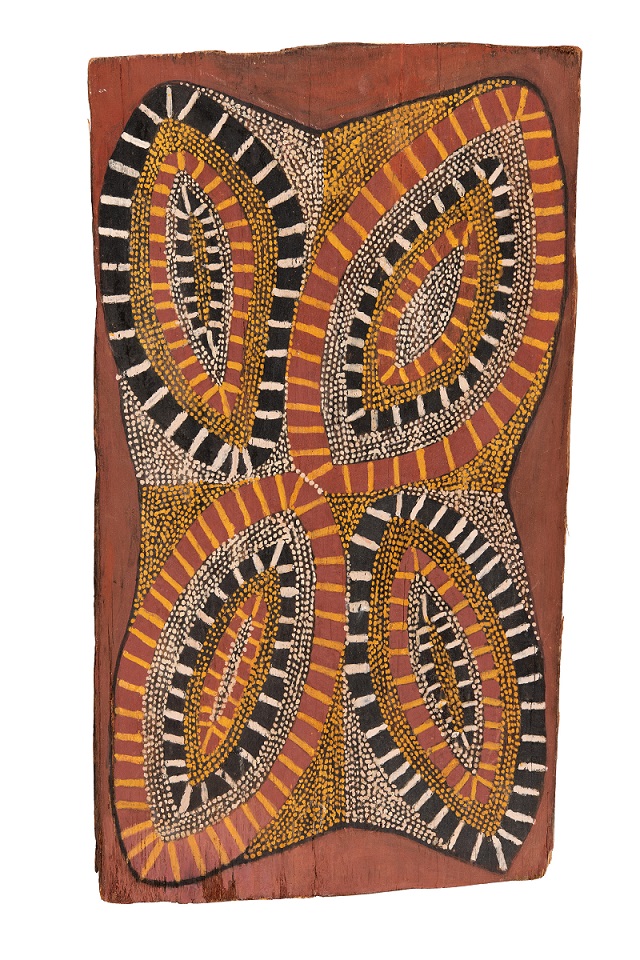
Tommy Pukualami Mungatopi (1923-1985), Coral, ca. 1968, natural earth pigment on eucalyptus bark, 53.5 x 29cm copyright VG Bild-Kunst Bonn, 2022. Inspiriert vom Land Vorschau
The Gerd and Helga Plewig Collection
In 1969, after completing his medical studies in the USA, Gerd Plewig went on a journey to Australia and, in Sydney, bought a bark painting showing a kangaroo. This became the foundation for a collection of historical bark paintings from northern Australia, mainly Arnhem Land, which today is considered the best outside of Australia. For the Aboriginal people, however, these paintings are deep and spiritual maps of their Country, which also form the basis for their land right claims. Arnhem Land lies in the most north-easterly part of the Northern Territory.
Its culture, over 60,000 years old, is famous for its rock and bark paintings. The rock paintings show aspects of the creation stories of Arnhem Land and, according to the Aboriginal people, they were created by the original ancestors themselves, who still live on in the paintings. The bark paintings are painted with natural earth pigments on eucalyptus bark and are based partly on the iconography of the rock paintings and partly on ceremonial body painting. They show ancestors and mythical beings, sometimes in the form of animals, alongside star constellations, natural phenomena and religious ceremonies. They are an expression of Mardayin, the sacred law which the ancestors introduced and which is still to be found today in songs, dances, paintings, ritual objects and ceremonies. The style of the bark paintings differs from region to region within Arnhem Land. In the west of Arnhem Land the so-called X-ray style has become famous. This style makes the skeletons and internal organs of humans and animals visible and is testimony to the great anatomical knowledge of the Aboriginal people. Cross-hatching is another important characteristic of the art of Arnhem Land.
The earliest bark paintings collected by Europeans in the 1870s originated from abandoned bark shelters on the Cobourg Peninsula and are now in the Macleay Museum in Sydney. From 1912 the anthropologist Baldwin Spencer researched the rock paintings in the region of Oenpelli (today Gunbalanya) and until 1920 he commissioned bark paintings there, which he donated to the National Museum of Victoria in Melbourne. From then on a market developed for this type of painting. In the north east of Arnhem Land from the 1930s works of art were also created for sale through the influence of missionaries.
The earliest bark paintings in the Plewig collection were created in the 1920s and 1930s, however, most of them are from the period from 1950 to the mid-1970s. At that time the artists of Arnhem Land were trying to convey the importance of Aboriginal culture to the world through their paintings. As ritual leaders of their clans they used their art to demonstrate their close connection to Country and to fight for their land rights.
The Plewig collection consists of 170 bark paintings from Arnhem Land and the Kimberley region which were donated to the Museum Fünf Kontinente in 2018 via the Collective Foundation in support of the Bavarian State Museums.
The exhibition shows a representative range of paintings, including works by such renowned artists as Yirrwala (also known as Yirawala), Dick Nuleingulei Murrumurru, Mawalan Marika or Mungurrawuy Yunupingu.
Location:
Museum Fünf Kontinente
Staatliche Museen in Bayern
Maximilianstraße 42
80538 München
SOURCE: Museum Fünf Kontinente, Staatliche Museen in Bayern